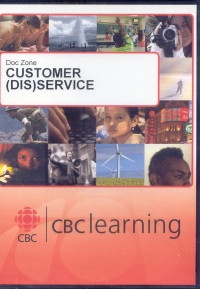| ________________
CM . . . . Volume XVIII Number 38 . . . . June 1, 2012
A slogan in retail of bygone days once proclaimed, "The customer is always right". That may be held as truth today, but the path of customer complaint to customer satisfaction has entered a wilderness that may have no exit. Customer (Dis)Service, by its title alone, makes clear the fact that there is a disconnect growing between customers and those who are expected to provide goods and/or service. This film is a revealing look into the world of customer service that will make anyone shudder when a voice prompt on the phone tells you to push anything for help. In the past, companies stood behind their products. Sales people "had your back", and "customer service was key". Problems were quickly resolved. However, with society's fascination with cheaper goods and companies trying to squeeze more out of fewer workers, there no longer seems to be that desire to truly solve problems of discontent. Floor staff is reduced to the point where it is difficult for customers to find anyone to help them. Those on the floor seem disinterested initially, and, if a sale is not imminent, they move on to someone else. In order to become more efficient, centralization of customer service became a natural progression. However, according to the film, here is where the process became "dehumanized". Technology was to streamline the process and remove repetitive activities; however, "pushing buttons with voice prompts makes you feel that you won't get anywhere". To cut costs, many companies have contracted out their customer service departments off-shore. These call centres can be available 24/7, and in New Delhi, for example, workers do this for "$400 a month". "Call school" teaches them how to work the caller and "always be in control of the call". Call centre personnel are taught to talk in a variety of accents. Using Google to gather bits of information about the caller's home area, they can pass as someone not far away-especially when they give themselves local sounding names and talk about the local weather. The expectations on these workers are very demanding. One worker lost his job because of a caller's complaint. However, the fact that the worker is unemployed means nothing for getting any satisfaction from the company. Many are lined up for the vacant job. While the phone angle of customer service seems taken from a Kafka novel, the film shows examples of people fighting back. YouTube proved very useful for Dave Carroll in his fight with United Airlines when they broke his guitar and refused to take his concern seriously. Other sites are provided for getting access to companies that try to hide behind automated systems, robotic voices or offshore call centres. However, the future looks bleak for human contact. Computer programs exist that can detect tone in a caller's voice and replicate conversation. The film comments that "technology allows us to connect to each other, but not with each other." Customer (Dis)Service is an entertaining film and, at the same time, is disturbing. We are given a look behind the curtain, but that does not matter. In the name of efficiency, personal touch has disappeared. When we actually get a human being who can deal with a situation and provide a solution, we are shocked. This film would be good in a Media or Advertising class. It would also have value in Sociology, Marketing, Business, or Psychology. As it is divided into sections, there is no need to show the entire film at one sitting. Each chapter could be viewed individually and discussed within a regular class period. Viewing this film will certainly change how you use the phone for customer service. Recommended. Frank Loreto is a teacher-librarian at St. Thomas Aquinas Secondary School in Brampton, ON.
To comment
on this title or this review, send mail to cm@umanitoba.ca.
Copyright © the Manitoba Library Association. Reproduction for personal
use is permitted only if this copyright notice is maintained. Any
other reproduction is prohibited without permission.
NEXT REVIEW |
TABLE OF CONTENTS FOR THIS ISSUE
- June 1, 2012.
AUTHORS |
TITLES |
MEDIA REVIEWS |
PROFILES |
BACK ISSUES |
SEARCH |
CMARCHIVE |
HOME |
